Milly White's Blog, page 54
January 3, 2016
3 Top Tips to Plan Ahead for 5:2 Diet Days
 3 Top Tips to Plan Ahead for 5:2 Diet Days Planning ahead can really help with keeping to the 500 or 600 restricted-calorie target on 5:2 Diet Fasting Days. Get into the habit of planning in advance what you are going to eat on your diet days. Follow these 3 Top Tips to plan ahead for 5:2 Diet Days:
3 Top Tips to Plan Ahead for 5:2 Diet Days Planning ahead can really help with keeping to the 500 or 600 restricted-calorie target on 5:2 Diet Fasting Days. Get into the habit of planning in advance what you are going to eat on your diet days. Follow these 3 Top Tips to plan ahead for 5:2 Diet Days:Choose delicious foods that won't leave you feeling hungry or unsatisfied after eating, keeping both hunger and boredom at bay. Shop for the ingredients ahead of time. It’s not a good idea to be wandering around the tempting aisles of the supermarket on your diet day.Keep a selection of easy, tasty low calorie meal recipes to hand for breakfast, lunch and dinner, as these will really help make your diet days successful and stress-free.Free 5:2 Diet 1 -Day Taster Menu & Shopping List
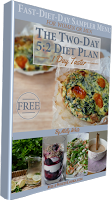 If you’re looking for inspiration, why not try my free 1 Fast-Diet-Day Sampler Menu? It adds up to a mere 503 calories (for women) or 575 calories (for men) but includes:Pre-Breakfast: Wake-Me-Up Morning Tonic (V)Breakfast: Toasted Quinoa & Blackberry Parfait (V)Lunch: Spinach, Tomato & Parmesan Crustless Quiche (V)Dinner: Smoked Turkey & Orzo Spiralizer Salad or Feta & Orzo Spiralizer Salad (V)Supper: Sleep-Tight Digestive Supper Cup (V).
If you’re looking for inspiration, why not try my free 1 Fast-Diet-Day Sampler Menu? It adds up to a mere 503 calories (for women) or 575 calories (for men) but includes:Pre-Breakfast: Wake-Me-Up Morning Tonic (V)Breakfast: Toasted Quinoa & Blackberry Parfait (V)Lunch: Spinach, Tomato & Parmesan Crustless Quiche (V)Dinner: Smoked Turkey & Orzo Spiralizer Salad or Feta & Orzo Spiralizer Salad (V)Supper: Sleep-Tight Digestive Supper Cup (V).

Published on January 03, 2016 07:56
December 10, 2015
The Sweetest Christmas - Gluten-free Christmas Desserts
 Gluten-free Christmas Black Forest Trifle The Sweetest Christmas - Gluten-free Christmas Desserts
Gluten-free Christmas Black Forest Trifle The Sweetest Christmas - Gluten-free Christmas Desserts
 It's not just about traditional Christmas Pudding at this time of year. From Black Forest Trifle (above) to individual Pear & Almond Frangipanes (left) there’s a Gluten-free Christmas Dessert that will fit the bill for all occasions over the whole of the festive season. Discover all this deliciousness and plus lots more in the Festive Desserts, Puddings & Sweet Sauces chapter of my new Gluten-free Christmas Holiday Festive Feasts & Treats Cookbook.
It's not just about traditional Christmas Pudding at this time of year. From Black Forest Trifle (above) to individual Pear & Almond Frangipanes (left) there’s a Gluten-free Christmas Dessert that will fit the bill for all occasions over the whole of the festive season. Discover all this deliciousness and plus lots more in the Festive Desserts, Puddings & Sweet Sauces chapter of my new Gluten-free Christmas Holiday Festive Feasts & Treats Cookbook. Available to buy as a Paperback & eBook from Amazon:
As an eBook from:



PS: If you also LOVE a gluten-free traditional Christmas Pudding, I've got that covered too, watch my video demonstration here!
Published on December 10, 2015 06:43
December 9, 2015
Quick, Easy Low Fat Dips,Skinny Nibbles & Delicious Party Foods to Share & Enjoy
 Low Fat Dips, Skinny Nibbles & Healthier Dippers 50+ Diet Recipe Cookbook
Low Fat Dips, Skinny Nibbles & Healthier Dippers 50+ Diet Recipe Cookbook
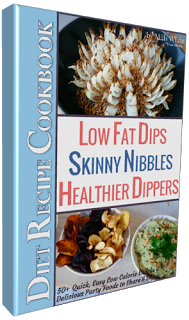 Parties can be a time when our healthy-eating good intentions fly out the window. No-one wants to be a party-pooper, constantly saying “no” to what’s on offer whilst everyone else tucks in. On the other hand, it’s all too easy to over-indulge in high calorie, high-fat snacks and find you’ve eaten almost a day’s worth of calories without even having a meal. Shop-bought processed-food snacks are definitely a danger-zone, as they are often loaded with:
Parties can be a time when our healthy-eating good intentions fly out the window. No-one wants to be a party-pooper, constantly saying “no” to what’s on offer whilst everyone else tucks in. On the other hand, it’s all too easy to over-indulge in high calorie, high-fat snacks and find you’ve eaten almost a day’s worth of calories without even having a meal. Shop-bought processed-food snacks are definitely a danger-zone, as they are often loaded with:fat, especially saturated fats and/or trans fatsrefined sugars and/orhigh levels of salt.Sadly this can also be true of even traditional home-made party recipes.
The good news is that it doesn’t have to be this way! If you crave an indulgent dip, snack or canapé but think they are “off-limits” as part of either a diet or just a healthy-eating regime, think again! You can go to the party and still enjoy delicious Canapés, Nibbles, Dips, Dippers & Dunkers but all made healthier and lower in calories, total fat and saturated fat.
Quick, Easy Low Calorie Snacks & Delicious Party Foods to Share & EnjoyWhether it’s a buffet at a family gathering during festive holidays such as Thanksgiving, Christmas & New Year or a fun summer-time BBQ party, you’ll find all the party foods you need including:
Skinny Canapés & Nibbles Recipes including Red Pepper Caponata Bruschetta, Maple Spiced Chickpeas & Seeds and Boozy Devils on HorsebackDelicious Low Fat Dips Recipes including Roasted Garlic & Pepper Dip, Caramelised Onion, Apple & Crispy Prosciutto Dip and Toasted Pine Nut, Avocado, Artichoke & Feta DipHealthier Dippers, Dunkers & Chips Recipes including Blooming Onion, Cheesy Courgette Crisps and Mustard & Cumin Seeded Parsnip FingersLow Calorie Pâtés, Terrines, Spreads & Toasts Recipes including Smoked Mackerel Pâté, Spiced Red Lentil & Sweet Potato Pâté and Chicken Liver Parfaits.Available to buy as a Paperback & eBook from Amazon:
As an eBook from:



Published on December 09, 2015 05:59
November 23, 2015
Gluten Free Christmas Holiday Festive Feasts & Treats 100+ Recipe Cookbook
 Gluten Free Christmas Holiday Festive Feasts & Treats 100+ Recipe Cookbook
Gluten Free Christmas Holiday Festive Feasts & Treats 100+ Recipe Cookbook
 Christmas and holidays such as Thanksgiving are a time for festive celebrations with family & friends, a time for sharing good food with those we love & care for. It’s a season for traditions, a time for happily-remembered flavours, tantalizing tastes and mouth-watering aromas. Whether you are looking for a gluten-free version of a traditional time-honoured favourite or perhaps you want a change & variety, with something new, fun, delicious and different? In this cookbook, you’ll find:
Christmas and holidays such as Thanksgiving are a time for festive celebrations with family & friends, a time for sharing good food with those we love & care for. It’s a season for traditions, a time for happily-remembered flavours, tantalizing tastes and mouth-watering aromas. Whether you are looking for a gluten-free version of a traditional time-honoured favourite or perhaps you want a change & variety, with something new, fun, delicious and different? In this cookbook, you’ll find:ideas how to get ahead with tips on shopping, cooking & freezing well in advance of the big dayshopping lists both to plan-ahead & so-you-don’t-forget edible gifts to share the gluten-free joymore than 100 crowd-pleasing recipes to suit all tastes and occasions, plus ideas on what to do with leftovers.Over 100 Gluten-free & Wheat-free Recipes
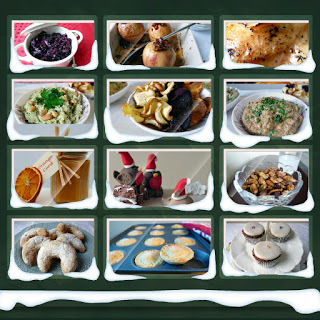 Over 100 Gluten-free Christmas & Holiday RecipesIn the
Christmas Holiday Festive Feasts & Treats 100+ Recipe Cookbook
, you will find all the recipes you need here to make it a perfect gluten-free Christmas celebration for everyone including:
Over 100 Gluten-free Christmas & Holiday RecipesIn the
Christmas Holiday Festive Feasts & Treats 100+ Recipe Cookbook
, you will find all the recipes you need here to make it a perfect gluten-free Christmas celebration for everyone including:The Christmas Cookie Jar Around the World including Lebkuchen, Vanillekipferl and FlorentinesMake It & Store It To Gift It or Keep It including Luxury Bejewelled Christmas Mincemeat and Milly’s Ultimate Christmas PuddingChristmas Cakes & Sweet Bakes including Mince Pies, Pistachio Financiers and Modern Cute Christmas CakeCanapés, Nibbles, Dips & Dippers including Maple Spiced Nuts & Seeds and Toasted Pine Nut, Artichoke & Caper DipChristmas Day Breakfast including Ginger Pear Crunch Muesli and Apple, Cranberry & Fig Breakfast CrispsChristmas Day Dinner & all the Trimmings including Lemon & Herb Roasted Turkey, Winter Fruits & Chestnut Stuffing Roll and Gluten-free Bread SauceSuper Sides including Mulled Cider Braised Red Cabbage and Wild Mushroom & Green Bean Casserole with Crispy ShallotsFestive Desserts, Puddings & Sweet Sauces including Black Forest Trifle and Amaretto CheesecakeLovely Leftovers including Slow-Cooked Split Pea & Ham Soup and Cheese & Parsnip Pies.Each recipe is completely gluten-free. All recipes include full nutritional information, indicating too whether they are also:
Dairy-Free | Oat-Free | Nut-Free | Vegetarian | Vegan | Yeast-Free.Your First Gluten-free Christmas or Holiday Celebration?The holiday season is particularly a time where you may be cooking this gluten-free for the first time for a guest or family member. If gluten-free cooking is new to you, you may be feeling anxious and a little bit over-whelmed by it all! This cookbook, will guide you through your first gluten-free Christmas or holiday celebration. You’ll find detailed advice on:
what to look for on food labels when shopping for the festive periodhow to make sure your kitchen is a safe area to prepare gluten-free meals, snacks & drinksany special tips or techniques that help make gluten-free recipes fool-proof, simple & reliable.Available to buy as a Paperback & eBook from Amazon:
As an eBook from:



Published on November 23, 2015 03:58
October 9, 2015
Healthy Brunch & Breakfast Eats Easy Low Fat & Low Cholesterol Recipe Cookbook

Healthy Brunch & Breakfast Eats Easy Low Fat & Low Cholesterol Recipe Cookbook
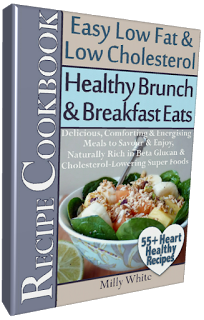 Whether it’s a quick, early bite to eat on a busy, weekday morning or a relaxed and leisurely brunch with the papers at the weekend, breakfast is often described as the most important meal of the day. Unfortunately, typical breakfast choices these days can be high in saturated and/or trans-fats, over-loaded with refined sugar, high in salt and low in dietary fibre.
Whether it’s a quick, early bite to eat on a busy, weekday morning or a relaxed and leisurely brunch with the papers at the weekend, breakfast is often described as the most important meal of the day. Unfortunately, typical breakfast choices these days can be high in saturated and/or trans-fats, over-loaded with refined sugar, high in salt and low in dietary fibre.However, it really doesn’t have to be this way! Eating breakfast can be both delicious and healthy, especially as breakfast offers a great opportunity to increase your dietary intake of beta glucan. This cookbook will provide a wide variety of healthier breakfast and brunch dishes to savour and enjoy that are low in saturated fat, trans-fat, salt and refined sugar.
There are plenty of breakfast and brunch options from quick, easy, healthy breakfast dishes on-the-go on early-start mornings through to indulgent and sociable brunch meals for later, longer weekend mornings. There are recipes that you can prepare ahead and even ones that can the prepared overnight.
Over 55 Cholesterol-Lowering Heart-Healthy Recipes
 Over 55 Heart-Healthy Low Cholesterol Low Fat RecipesIn the
Healthy Brunch & Breakfast Eats Recipe Cookbook
, you will find low fat & low cholesterol meal ideas including:
Over 55 Heart-Healthy Low Cholesterol Low Fat RecipesIn the
Healthy Brunch & Breakfast Eats Recipe Cookbook
, you will find low fat & low cholesterol meal ideas including:Porridge & Soaked Overnight Oats including Strawberry Cheesecake Overnight OatsBreakfast Mushrooms including Golden Mushroom Hash BrownsBreakfast Fruits including Peach, Raspberry & Pistachio Breakfast CrispLove Your Heart’ Super-Green Smoothies including Plum Crazy For Granola Green SmoothieBreakfast Salads including Tropical Fruit Breakfast Salad with Warm Granola SprinkleMuesli & Granolas including Nutastic Seeded Muesli (Fruit-Free)Breakfast Bakes including Apple, Oat & Pumpkin Seed SconesBreakfast Eggs including Cheesy Eggs FlorentineEach recipe is low in saturated fat and many are rich in beta-glucan. There are lots of recipes that are also Vegetarian and Vegan.
A Guide to Cholesterol & a Heart-Healthy Diet
The book also guides you through simple to understand information about:
Different Types Of CholesterolGood vs Bad Fats, Dietary Cholesterol & Heart-HealthLowering Cholesterol With a Healthy, Balanced DietFoods Naturally Rich in Beta Glucan & Other Cholesterol-Busting Superfoods.Take a peek at this video preview:
Available to buy as a Paperback & eBook from Amazon:
As an eBook from:



Published on October 09, 2015 02:33
October 7, 2015
8 Reasons to Breakfast Like a King for Health
We're often told to 'Breakfast like a King, Lunch like a Prince and Dine like a Pauper, but should we listen to this old adage? Well, in this case, yes, and here's why:
 8 Reasons to Breakfast Like a King for Health1. Breakfast Can Improve Your Overall Diet.
8 Reasons to Breakfast Like a King for Health1. Breakfast Can Improve Your Overall Diet.
People who eat breakfast have higher daily intakes of healthy fibre and nutrients such as Calcium, Zinc, Iron, Riboflavin, and Vitamins A & C. They are also more likely to meet overall nutrient intake recommendations compared those who skip breakfast (Nutr Rev. June 2007)2. Breakfast Can Improve Heart Health.
Researchers found that men who regularly skipped breakfast had a 27% higher risk of heart disease than those who did eat a morning meal (American Heart Association Journal Circulation, May 2013)3. Breakfast Can Improve Regulation of Insulin Levels.
Research found that not eating breakfast every day increased the risk of developing type 2 diabetes, even if breakfast was skipped on just a few days per week (Journal of Epidemiol, Mar 2015).4. Breakfast Can Reduce the Risk of Cancer.
Research found eating a fibre-rich breakfast can help maintain a healthy digestive system and reduce colorectal cancer risk (PLoS One June 2012).5. Breakfast Can Be Good for Physical Energy.
Research which found people who ate breakfast tended to be more active during the remainder of the day in mostly light-intensity activity (American Journal of Clinical Nutrition, Apr 2014)6. Breakfast Can Help Help Increase Academic Achievement In Children.
Research which found that children who improved their nutrition with breakfast enjoyed significant improvements in academic performance (Ann Nutr Metab, 2002)7. Breakfast Can Help with Weight Loss.
Research which found that dieters who ate higher-protein based breakfasts felt more satisfied and ate fewer calories at the following meal (Int Journal of Obesity, Aug 2008)8. Breakfast Can Help Maintain a Healthy Body Weight.
Research also found that people who had lost weight and maintained their weight loss, regularly ate breakfast (Obesity Research, Feb 2002)So, Breakfast Like a King on Weekdays, Weekends & Holidays too!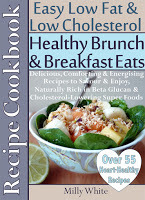 Breakfast is a fabulous meal to eat well for good health. However, just because eating breakfast can be “a good thing”, it's not always easy to make healthy choices. Unfortunately, some of the typical breakfast choices we can make these days can be high in saturated and/or trans-fats, over-loaded with refined sugar, high in salt and low in dietary fibre. Culprits can include bacon, sausages, breakfast breads, rolls and pastries and even apparently “healthy” cereals. My
Easy Low Fat and Low Cholesterol Healthy Brunch & Breakfast Eats Recipe Cookbook
helps with this dilemma, providing over 55 Easy & Healthy Recipes for breakfast & brunch, available:
Breakfast is a fabulous meal to eat well for good health. However, just because eating breakfast can be “a good thing”, it's not always easy to make healthy choices. Unfortunately, some of the typical breakfast choices we can make these days can be high in saturated and/or trans-fats, over-loaded with refined sugar, high in salt and low in dietary fibre. Culprits can include bacon, sausages, breakfast breads, rolls and pastries and even apparently “healthy” cereals. My
Easy Low Fat and Low Cholesterol Healthy Brunch & Breakfast Eats Recipe Cookbook
helps with this dilemma, providing over 55 Easy & Healthy Recipes for breakfast & brunch, available:
As a Paperback & eBook from Amazon:
As an eBook from:


 8 Reasons to Breakfast Like a King for Health1. Breakfast Can Improve Your Overall Diet.
8 Reasons to Breakfast Like a King for Health1. Breakfast Can Improve Your Overall Diet. People who eat breakfast have higher daily intakes of healthy fibre and nutrients such as Calcium, Zinc, Iron, Riboflavin, and Vitamins A & C. They are also more likely to meet overall nutrient intake recommendations compared those who skip breakfast (Nutr Rev. June 2007)2. Breakfast Can Improve Heart Health.
Researchers found that men who regularly skipped breakfast had a 27% higher risk of heart disease than those who did eat a morning meal (American Heart Association Journal Circulation, May 2013)3. Breakfast Can Improve Regulation of Insulin Levels.
Research found that not eating breakfast every day increased the risk of developing type 2 diabetes, even if breakfast was skipped on just a few days per week (Journal of Epidemiol, Mar 2015).4. Breakfast Can Reduce the Risk of Cancer.
Research found eating a fibre-rich breakfast can help maintain a healthy digestive system and reduce colorectal cancer risk (PLoS One June 2012).5. Breakfast Can Be Good for Physical Energy.
Research which found people who ate breakfast tended to be more active during the remainder of the day in mostly light-intensity activity (American Journal of Clinical Nutrition, Apr 2014)6. Breakfast Can Help Help Increase Academic Achievement In Children.
Research which found that children who improved their nutrition with breakfast enjoyed significant improvements in academic performance (Ann Nutr Metab, 2002)7. Breakfast Can Help with Weight Loss.
Research which found that dieters who ate higher-protein based breakfasts felt more satisfied and ate fewer calories at the following meal (Int Journal of Obesity, Aug 2008)8. Breakfast Can Help Maintain a Healthy Body Weight.
Research also found that people who had lost weight and maintained their weight loss, regularly ate breakfast (Obesity Research, Feb 2002)So, Breakfast Like a King on Weekdays, Weekends & Holidays too!
 Breakfast is a fabulous meal to eat well for good health. However, just because eating breakfast can be “a good thing”, it's not always easy to make healthy choices. Unfortunately, some of the typical breakfast choices we can make these days can be high in saturated and/or trans-fats, over-loaded with refined sugar, high in salt and low in dietary fibre. Culprits can include bacon, sausages, breakfast breads, rolls and pastries and even apparently “healthy” cereals. My
Easy Low Fat and Low Cholesterol Healthy Brunch & Breakfast Eats Recipe Cookbook
helps with this dilemma, providing over 55 Easy & Healthy Recipes for breakfast & brunch, available:
Breakfast is a fabulous meal to eat well for good health. However, just because eating breakfast can be “a good thing”, it's not always easy to make healthy choices. Unfortunately, some of the typical breakfast choices we can make these days can be high in saturated and/or trans-fats, over-loaded with refined sugar, high in salt and low in dietary fibre. Culprits can include bacon, sausages, breakfast breads, rolls and pastries and even apparently “healthy” cereals. My
Easy Low Fat and Low Cholesterol Healthy Brunch & Breakfast Eats Recipe Cookbook
helps with this dilemma, providing over 55 Easy & Healthy Recipes for breakfast & brunch, available:As a Paperback & eBook from Amazon:
As an eBook from:



Published on October 07, 2015 06:26
September 12, 2015
The Facts About Fats: Good vs Bad & Why We All Need Fat in our Diet (Infographic)
The Facts About Fats: Good vs Bad
 Are you confused about whether fats, in any form, should form part of a healthy diet? Don't worry, you are not alone! You’re probably so used to reading and hearing that fat is the enemy, that you may be surprised to learn that actually we all do need some fat in our diet. However, it can be very confusing, for example:
Are you confused about whether fats, in any form, should form part of a healthy diet? Don't worry, you are not alone! You’re probably so used to reading and hearing that fat is the enemy, that you may be surprised to learn that actually we all do need some fat in our diet. However, it can be very confusing, for example:
what exactly are good fats vs bad fats?how much fat we should eat as part of a normal healthy diet or if we want to lose weight ?which types of fats should we avoid at all costs and which fats should we eat more of?what about avoiding dietary cholesterol too?
Why We All Need Some Fat in Our diet:to help provide energy, healthy brain function & cell growthas a source of some essential fats that our bodies cannot make to help our bodies absorb and use fat-soluble vitamins (A, D, E and K). However, research has shown that cutting down on saturated fat and replacing it with everyday foods that contain more unsaturated fat can improve our both our heart health and brain health, and even help keep us genetically younger.
 Monounsaturated Fats (MUFAs):
Monounsaturated Fats (MUFAs):
These are also mostly liquid at room temperature and made from vegetable sources.
Foods rich in mono unsaturated fats include:
Nuts, flaxseedOlive Oil, Rapeseed Oil, Canola oil and spreads based on theseAvocadoResearch has shown that eating foods rich in monounsaturated fats improves blood serum cholesterol levels, which can lower your risk of heart disease. Some studies have also linked MUFAs with improved insulin levels and blood sugar control, important in the prevention and management of diabetes.
Polyunsaturated Fats (PUFAs):
In pure form, these are usually liquid at room temperature and are made from vegetable sources. They can also be found abundantly in certain types of fish. Foods which are a rich source of polyunsaturated fats include:
Oily fish such as mackerel, salmon, trout, pilchards, sardines, herring, anchovies, which are rich Omega-3 fatty acidsCorn, safflower and sunflower oils & spreadsSunflower and other edible seedsResearch has shown that eating a diet rich in polyunsaturated fats improves blood cholesterol levels, which can decrease your risk of heart disease. Again, studies have also linked PUFAs with helping to reduce the risk of developing type 2 diabetes.
Saturated Fats:
These are usually solid at room temperature and often from animal sources. Foods high in saturated fats include:
Fatty meat and meat products (Burgers, sausages, salami)Dairy fats (full cream milk, cheese, full fat yogurt, full fat crème fresh and cream)Butter, block margarine, ghee, lardPalm and coconut oilsProcessed foods and baked goods made from the above (pies, pasties, cakes, biscuits, pastries, puddings, Indian sweets, pies, and pasties)There have been numerous research studies into the risks associated with a diet high in saturated fats. A recent (June 2015) Cochrane Review of 15 studies into The Effect Of Cutting Down On The Saturated Fat We Eat concluded that changing the type of fat we eat, replacing saturated fats with polyunsaturated fats, seems to protect us better, reducing our risk of heart and vascular problems. We should aim to replace most of the saturated fats in our diet with healthier unsaturated fats, and saturated fats should only be eaten in moderation.
Trans Fats (Partially Hydrogenated):
Whilst trans fats can occur naturally in some diary and meat whole foods in very small quantities, they are more usually formed during food processing when hydrogen is added to vegetable oil (a process called hydrogenation) to make it more solid. This is why they may be described as partially hydrogenated fats on food labels. Foods high in trans fats include:
Takeaway and fast foodDeep fried foodsProcessed snacks, cakes and desserts such as microwave popcorn, fried crisps and chips, crackers, biscuits, cookies, cakes, pastries, pizza, pies and other baked goodsCoffee creamerSome hard vegetable shortenings and stick margarinesThe scientific evidence against processed trans fats (partially hydrogenated fats) for good health is so over-whelming that the advice is to eliminate these completely from your diet.
What About Cholesterol?
There is an enduring but mistaken myth that dietary cholesterol is one of the causes of raised bad (LDL) blood cholesterol. In the UK, government guidelines do not advocate any restriction on dietary cholesterol unless you are managing the inherited cholesterol condition, familial hypercholesterolaemia (discover more about FH at HEARTUK – the Cholesterol charity here). Previously, the USA had advised that everyone should keep dietary cholesterol to less than 300mg per day. However, as there is no clear scientific link between the cholesterol people eat and blood cholesterol levels, in Feb 2015 this advice was rescinded (link health.gov/dietaryguidelines/2015-scientific-report) with focus now on reducing saturated fats and trans fats instead, which are to blame for high cholesterol.
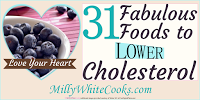
You can discover more about fabulous foods that can help lower cholesterol here.
Managing Your Total Fat & Lowering Your Saturated Fat Intake
Research has shown that reducing saturated fat intake can bring about a reduction in harmful LDL-cholesterol. A healthy fat intake is based on your energy needs and activity levels. An average man requires around 2,500 calories (kcals) per day and average woman 2,000 calories (kcals) per day. No more than 30% of these calories should come from fat. For most men that means not more than 95g of fat per day and for women no more than 70g fat. Please note, calorie needs may be more or less, depending on your weight and personal activity level.
Guidance in the UK & USA recommends lowering saturated fat intake to less than 10% of energy intake. If you need to lose weight, you may need to reduce your fat intake further, since all sources of fat are a concentrated source of calories (1g of fat equates to around 9 kcals).

If you are on a reduced-calorie diet for weight-loss, your recommended fat intake will adjust down in proportion to the reduced calorie intake. The table below details the amounts suggested for either a 1500kcal or 1200kcal daily intake, which is often the recommended calorie in-take for a weight-loss diet.
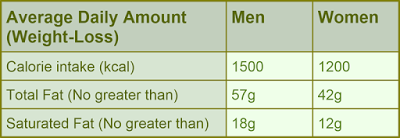
4 Top Tips on Eating Fats as Part of a Healthy Diet
Read Labels! Be aware that trans-fats/partially hydrogenated fats can crop up in the most unexpected places. Watch out for them in processed foods such as shop-bought baked goods including cakes, biscuits, cookies & bars, peanut butter and fried foods. It used to be that baking fats, margarine and spreads contained partially hydrogenated fats but in response to health concerns, most manufacturers no longer include them, however always check the label! Eat a Mediterranean Diet! The Mediterranean Diet is not a low fat diet per se, but the fat you do eat comes mainly from plants and cold-water fish rather than from saturated sources like high-fat dairy products, fatty meats or processed foods. You can find much more information on the delicious whole foods in the Mediterranean Diet here and below.Eat Low-Fat Not No-Fat! Our bodies need some fat in order absorb and use fat-soluble vitamins (A, D, E and K) found naturally in some foods. So enjoy some delicious healthy unsaturated fats alongside naturally nutritious, whole foods. Sprinkle nuts or seeds over salads, use olive, rapeseed (canola) and sunflower oils, choose unsalted, natural nut butters and low-fat (not fat-free) milk and cheeses.Eat Eggs & Shrimps (& more)! Unless following specific medical advice, don’t worry about, or avoid, foods that are high in dietary cholesterol as long as they are also low in saturated fat. There are many such foods to enjoy such as whole eggs and seafood including shrimp, prawns, crab, lobster & squid. Lean offal meat is such as liver & kidney is also good, although limit liver or liver pâté to a once a week treat in order to avoid consuming too much Vitamin A (and avoid if pregnant or planning a pregnancy).
Help in Following the Mediterranean DietSometime it can be hard to translate the good intentions to follow a Mediterranean-style Diet into everyday eating and meals the whole family will enjoy. If you feel like that then please do take a look my Easy Low Fat and Low Cholesterol Recipe Mediterranean Diet Cookbook, which really helps with this dilemma and provided over 100 delicious, low saturated fat recipes for breakfast, lunch and dinner. It's available:
As a Paperback & eBook from Amazon:
As an eBook from:


 Are you confused about whether fats, in any form, should form part of a healthy diet? Don't worry, you are not alone! You’re probably so used to reading and hearing that fat is the enemy, that you may be surprised to learn that actually we all do need some fat in our diet. However, it can be very confusing, for example:
Are you confused about whether fats, in any form, should form part of a healthy diet? Don't worry, you are not alone! You’re probably so used to reading and hearing that fat is the enemy, that you may be surprised to learn that actually we all do need some fat in our diet. However, it can be very confusing, for example:what exactly are good fats vs bad fats?how much fat we should eat as part of a normal healthy diet or if we want to lose weight ?which types of fats should we avoid at all costs and which fats should we eat more of?what about avoiding dietary cholesterol too?
Why We All Need Some Fat in Our diet:to help provide energy, healthy brain function & cell growthas a source of some essential fats that our bodies cannot make to help our bodies absorb and use fat-soluble vitamins (A, D, E and K). However, research has shown that cutting down on saturated fat and replacing it with everyday foods that contain more unsaturated fat can improve our both our heart health and brain health, and even help keep us genetically younger.
 Monounsaturated Fats (MUFAs):
Monounsaturated Fats (MUFAs):These are also mostly liquid at room temperature and made from vegetable sources.
Foods rich in mono unsaturated fats include:
Nuts, flaxseedOlive Oil, Rapeseed Oil, Canola oil and spreads based on theseAvocadoResearch has shown that eating foods rich in monounsaturated fats improves blood serum cholesterol levels, which can lower your risk of heart disease. Some studies have also linked MUFAs with improved insulin levels and blood sugar control, important in the prevention and management of diabetes.
Polyunsaturated Fats (PUFAs):
In pure form, these are usually liquid at room temperature and are made from vegetable sources. They can also be found abundantly in certain types of fish. Foods which are a rich source of polyunsaturated fats include:
Oily fish such as mackerel, salmon, trout, pilchards, sardines, herring, anchovies, which are rich Omega-3 fatty acidsCorn, safflower and sunflower oils & spreadsSunflower and other edible seedsResearch has shown that eating a diet rich in polyunsaturated fats improves blood cholesterol levels, which can decrease your risk of heart disease. Again, studies have also linked PUFAs with helping to reduce the risk of developing type 2 diabetes.
Saturated Fats:
These are usually solid at room temperature and often from animal sources. Foods high in saturated fats include:
Fatty meat and meat products (Burgers, sausages, salami)Dairy fats (full cream milk, cheese, full fat yogurt, full fat crème fresh and cream)Butter, block margarine, ghee, lardPalm and coconut oilsProcessed foods and baked goods made from the above (pies, pasties, cakes, biscuits, pastries, puddings, Indian sweets, pies, and pasties)There have been numerous research studies into the risks associated with a diet high in saturated fats. A recent (June 2015) Cochrane Review of 15 studies into The Effect Of Cutting Down On The Saturated Fat We Eat concluded that changing the type of fat we eat, replacing saturated fats with polyunsaturated fats, seems to protect us better, reducing our risk of heart and vascular problems. We should aim to replace most of the saturated fats in our diet with healthier unsaturated fats, and saturated fats should only be eaten in moderation.
Trans Fats (Partially Hydrogenated):
Whilst trans fats can occur naturally in some diary and meat whole foods in very small quantities, they are more usually formed during food processing when hydrogen is added to vegetable oil (a process called hydrogenation) to make it more solid. This is why they may be described as partially hydrogenated fats on food labels. Foods high in trans fats include:
Takeaway and fast foodDeep fried foodsProcessed snacks, cakes and desserts such as microwave popcorn, fried crisps and chips, crackers, biscuits, cookies, cakes, pastries, pizza, pies and other baked goodsCoffee creamerSome hard vegetable shortenings and stick margarinesThe scientific evidence against processed trans fats (partially hydrogenated fats) for good health is so over-whelming that the advice is to eliminate these completely from your diet.
What About Cholesterol?
There is an enduring but mistaken myth that dietary cholesterol is one of the causes of raised bad (LDL) blood cholesterol. In the UK, government guidelines do not advocate any restriction on dietary cholesterol unless you are managing the inherited cholesterol condition, familial hypercholesterolaemia (discover more about FH at HEARTUK – the Cholesterol charity here). Previously, the USA had advised that everyone should keep dietary cholesterol to less than 300mg per day. However, as there is no clear scientific link between the cholesterol people eat and blood cholesterol levels, in Feb 2015 this advice was rescinded (link health.gov/dietaryguidelines/2015-scientific-report) with focus now on reducing saturated fats and trans fats instead, which are to blame for high cholesterol.

You can discover more about fabulous foods that can help lower cholesterol here.
Managing Your Total Fat & Lowering Your Saturated Fat Intake
Research has shown that reducing saturated fat intake can bring about a reduction in harmful LDL-cholesterol. A healthy fat intake is based on your energy needs and activity levels. An average man requires around 2,500 calories (kcals) per day and average woman 2,000 calories (kcals) per day. No more than 30% of these calories should come from fat. For most men that means not more than 95g of fat per day and for women no more than 70g fat. Please note, calorie needs may be more or less, depending on your weight and personal activity level.
Guidance in the UK & USA recommends lowering saturated fat intake to less than 10% of energy intake. If you need to lose weight, you may need to reduce your fat intake further, since all sources of fat are a concentrated source of calories (1g of fat equates to around 9 kcals).

If you are on a reduced-calorie diet for weight-loss, your recommended fat intake will adjust down in proportion to the reduced calorie intake. The table below details the amounts suggested for either a 1500kcal or 1200kcal daily intake, which is often the recommended calorie in-take for a weight-loss diet.

4 Top Tips on Eating Fats as Part of a Healthy Diet
Read Labels! Be aware that trans-fats/partially hydrogenated fats can crop up in the most unexpected places. Watch out for them in processed foods such as shop-bought baked goods including cakes, biscuits, cookies & bars, peanut butter and fried foods. It used to be that baking fats, margarine and spreads contained partially hydrogenated fats but in response to health concerns, most manufacturers no longer include them, however always check the label! Eat a Mediterranean Diet! The Mediterranean Diet is not a low fat diet per se, but the fat you do eat comes mainly from plants and cold-water fish rather than from saturated sources like high-fat dairy products, fatty meats or processed foods. You can find much more information on the delicious whole foods in the Mediterranean Diet here and below.Eat Low-Fat Not No-Fat! Our bodies need some fat in order absorb and use fat-soluble vitamins (A, D, E and K) found naturally in some foods. So enjoy some delicious healthy unsaturated fats alongside naturally nutritious, whole foods. Sprinkle nuts or seeds over salads, use olive, rapeseed (canola) and sunflower oils, choose unsalted, natural nut butters and low-fat (not fat-free) milk and cheeses.Eat Eggs & Shrimps (& more)! Unless following specific medical advice, don’t worry about, or avoid, foods that are high in dietary cholesterol as long as they are also low in saturated fat. There are many such foods to enjoy such as whole eggs and seafood including shrimp, prawns, crab, lobster & squid. Lean offal meat is such as liver & kidney is also good, although limit liver or liver pâté to a once a week treat in order to avoid consuming too much Vitamin A (and avoid if pregnant or planning a pregnancy).
Help in Following the Mediterranean DietSometime it can be hard to translate the good intentions to follow a Mediterranean-style Diet into everyday eating and meals the whole family will enjoy. If you feel like that then please do take a look my Easy Low Fat and Low Cholesterol Recipe Mediterranean Diet Cookbook, which really helps with this dilemma and provided over 100 delicious, low saturated fat recipes for breakfast, lunch and dinner. It's available:
As a Paperback & eBook from Amazon:
As an eBook from:



Published on September 12, 2015 06:42
August 29, 2015
"Should I Eat Red Meat? - The Big Health Dilemma" with 5 Top Tips for Healthier Ways to Eat Red Meat
 Should I Eat Red Meat? - The Big Health DilemmaCan you eat meat, and in particular, red and processed meat as part of a healthy diet? There is quite a bit of debate on what are the health impacts of regularly consuming red meat and processed red meat products. Generally, "red" meat refers to cut of:
Should I Eat Red Meat? - The Big Health DilemmaCan you eat meat, and in particular, red and processed meat as part of a healthy diet? There is quite a bit of debate on what are the health impacts of regularly consuming red meat and processed red meat products. Generally, "red" meat refers to cut of:beefvealporkham/gammonlambmuttonvenison goatand processed red meat products include foods largely made from those meats such as sausages, burgers, bacon and ham.
What Does The Science Say About Red Meat? The research into red meat has centred around two major health concerns, heart health and cancer. There have been numerous studies published but four of the most respected include:
Red Meat Consumption and Mortality (Archive of Internal Medicine, April 2012) concluded that red meat consumption is associated with an increased risk of total Cardiovascular Diseases and Cancer mortality. Substitution of other healthy protein sources for red meat is associated with a lower mortality risk.Meat consumption and mortality - results from the European Prospective Investigation into Cancer and Nutrition (BMC, March 2013) concluded there was a moderate positive association between processed meat consumption and mortality, in particular due to Cardiovascular Diseases, but also to Cancer.One of two pieces of breakthrough research published in 2005 concluded that high consumption of red and processed meat was linked to bowl cancer risk, whereas a diet rich in fish actually reduced the risk - Meat, Fish, and Colorectal Cancer Risk (J Natl Cancer Inst. June 2005).The other study published in 2005 looked at the risks associated with long-term consumption of red meat and red meat products. Meat Consumption and Risk of Colorectal Cancer (JAMA Jan 2005) concluded that long-term high red meat consumption was linked to an increase in bowel cancer.So does this mean that red meat should be avoided at all costs? Not necessarily so! Red meat can be a rich source of certain vitamins, minerals and nutrients essential to health such as:
essential fatty acidsvitamins B12 and B3zincselenium ironprotein.However, the counter-balance to this is that red meat and especially processed red meat products, can be high in fat, and in particular, saturated fat. It comes down to how often you eat red meat and how you eat it, and as is often the case, the key is in balance and moderation. In the UK, it's recommended that you eat an average of 70g (2½ oz) or less of red meat per day.
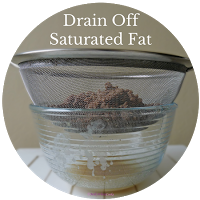 Lean Lamb Mince - Cooked & DrainedTake a look at the picture on the right. This is how I recommend you prepare lamb mince in my recipe for low fat Shepherd’s Pie (
Easy Low Fat & Low Cholesterol Mediterranean Diet Recipe Cookbook
) – the lean mince has been sautéd and then drained in a strainer to remove excess fat. In my picture, you can see 200g of raw, lean lamb mince, sautéd in a non-stick pan and then drained, yielded 40g of drained juices. I estimate that approximately half of this was fat.
Lean Lamb Mince - Cooked & DrainedTake a look at the picture on the right. This is how I recommend you prepare lamb mince in my recipe for low fat Shepherd’s Pie (
Easy Low Fat & Low Cholesterol Mediterranean Diet Recipe Cookbook
) – the lean mince has been sautéd and then drained in a strainer to remove excess fat. In my picture, you can see 200g of raw, lean lamb mince, sautéd in a non-stick pan and then drained, yielded 40g of drained juices. I estimate that approximately half of this was fat. 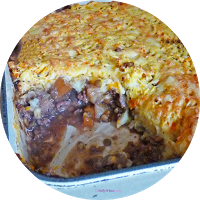 My low fat Shepherds Pie recipe (left) also mixes the drained, cooked lean lamb mince with the green lentils as a source of low-fat protein. By making these adjustments, and following my vegetable-packed recipe, a generous portion of my home-cooked low fat Shepherd’s Pie contains only 50g (1¾ oz) red meat and comes in at 437 cals, 14g Total Fat and just 6g of Saturated Fat.
My low fat Shepherds Pie recipe (left) also mixes the drained, cooked lean lamb mince with the green lentils as a source of low-fat protein. By making these adjustments, and following my vegetable-packed recipe, a generous portion of my home-cooked low fat Shepherd’s Pie contains only 50g (1¾ oz) red meat and comes in at 437 cals, 14g Total Fat and just 6g of Saturated Fat. 5 Top Tips for Healthier Ways to Eat Red Meat
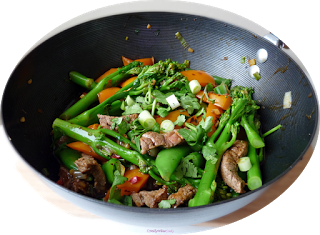 Choose lean cuts of red meat and trim away all visible fat before cooking.Cook in ways that drains away more fat during cooking such as grill streaks or dry frying then removing the fat that's accumulated.Reduce the red meat per serving in a recipe by substituting low-fat lentils, beans or mushrooms in place of some of the meat. These ingredients absorb the flavour of the meat used, have a "meaty" texture but result in much lower levels of saturated fat in the final dish.Use meat as a "garnish" rather than the main ingredient - think a vibrant vegetable-packed stir-fry or a fresh, colourful salad.Make red meat an occassional treat to be savoured and enjoyed, but not a daily event.Further Cooking Inspiration
Choose lean cuts of red meat and trim away all visible fat before cooking.Cook in ways that drains away more fat during cooking such as grill streaks or dry frying then removing the fat that's accumulated.Reduce the red meat per serving in a recipe by substituting low-fat lentils, beans or mushrooms in place of some of the meat. These ingredients absorb the flavour of the meat used, have a "meaty" texture but result in much lower levels of saturated fat in the final dish.Use meat as a "garnish" rather than the main ingredient - think a vibrant vegetable-packed stir-fry or a fresh, colourful salad.Make red meat an occassional treat to be savoured and enjoyed, but not a daily event.Further Cooking Inspiration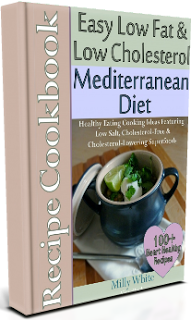 You can find lots of low fat, healthy recipe make-overs, including how you can eat some red meat as part of healthy, balanced diet in my Easy Low Fat & Low Cholesterol Mediterranean Diet Recipe Cookbook, available:
You can find lots of low fat, healthy recipe make-overs, including how you can eat some red meat as part of healthy, balanced diet in my Easy Low Fat & Low Cholesterol Mediterranean Diet Recipe Cookbook, available:As a Paperback & eBook from Amazon:
As an eBook from:



Published on August 29, 2015 09:00
August 23, 2015
Research Shows Low-Fat Packs a Mightier Diet Punch than Low-Carb!
 Ding, ding …… round 594 in the battle of the diets featuring Low Fat vs Low Carb Diets! And it appears that low-fat packs a mightier diet punch than low-carb.
Ding, ding …… round 594 in the battle of the diets featuring Low Fat vs Low Carb Diets! And it appears that low-fat packs a mightier diet punch than low-carb.In a recent scientific study, calorie-for-calorie reducing the fat in your diet lead to greater overall body fat loss when compared to reducing your carb intake by an equal amount of calories, (source: Cell Metabolism S1550-4131(15))
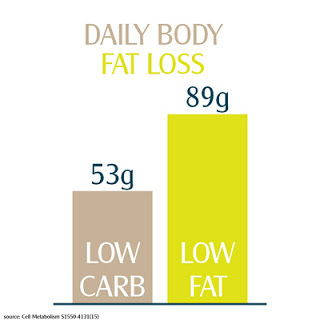 Daily Body Fat LossThe study took place in a confined, controlled environment (which elements the risk of error through mis-reporting by subjects). The group followed the same baseline diet for 5 days and were then split into 2 groups. One group had their calories reduced by 800 cals per day from a lower fat intake whilst the other group had the same calories reduction but this time from eating fewer carbs. As well as controlling the diet that was eaten by the group, the researchers from the National Institutes of Health also measured and analysed their levels of exercise.
Daily Body Fat LossThe study took place in a confined, controlled environment (which elements the risk of error through mis-reporting by subjects). The group followed the same baseline diet for 5 days and were then split into 2 groups. One group had their calories reduced by 800 cals per day from a lower fat intake whilst the other group had the same calories reduction but this time from eating fewer carbs. As well as controlling the diet that was eaten by the group, the researchers from the National Institutes of Health also measured and analysed their levels of exercise. Unsurprisingly, as both diets restricted total calorie intake compared with the baseline, they did each result in body fat loss in the two groups. However, those in the lower fat intake group lost significantly more body fat (an average of 89g per day versus 53g per day in the lower-carb group).
The Low-Fat Mediterranean Diet
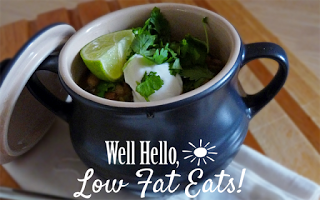 One of the most popular and truly healthy low-fat diets is the Mediterranean Diet, which doctors have described as a sure way to improve health. You can read more about the overall health benefits associated with the Mediterranean Diet here and here, and there is even evidence that it maintains brain health as you age.
One of the most popular and truly healthy low-fat diets is the Mediterranean Diet, which doctors have described as a sure way to improve health. You can read more about the overall health benefits associated with the Mediterranean Diet here and here, and there is even evidence that it maintains brain health as you age.Many experts advise that the "best diet" is the one that you can stick too, and with the low-fat Mediterranean Diet you can enjoy a wide variety of naturally delicious and filling meals.
Further InspirationIf you're looking easy ways to follow the Mediterranean Diet, then you may want to checkout my best-selling Easy Low Fat & Low Cholesterol Mediterranean Diet Recipe Cookbook which features over 100 easy, tasty everyday recipes.
Available as a paperback & Kindle book on:
Also, available as an ebook on:



Published on August 23, 2015 02:08
August 17, 2015
Periscope: How To Make Your Own Healthy Granola
Hello Scopers!
If you joined me on my live Periscope on How To Make Your Own Healthy Granola, here are the free downloads that I referenced in that live video:
Gluten-Free Recipes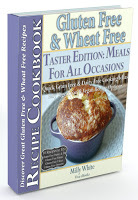 Discover this Taster Edition Recipe eBook which provides lots of inspiration for delicious, nutritious healthy gluten-free meals plus many feel-good favourites and treats for holidays and celebrations too. Each recipe is completely Gluten-Free and many are also:
Discover this Taster Edition Recipe eBook which provides lots of inspiration for delicious, nutritious healthy gluten-free meals plus many feel-good favourites and treats for holidays and celebrations too. Each recipe is completely Gluten-Free and many are also:
| Dairy-Free | Oat-Free | Nut-Free | Vegetarian | Vegan | Yeast-Free |
You can download your FREE copy of my Gluten-Free Meals for All Occasions Recipe Booklet here.
Low-Fat Low Cholesterol Mediterranean Diet Recipes
You can download my Healthy Heart Granola recipe here.
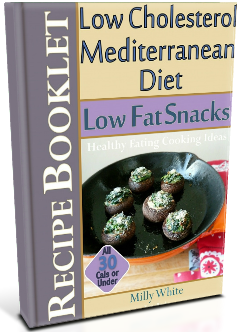 To get your FREE Mediterranean Diet Low Fat Snacks Recipes Booklet, you just need to tell me where to email it!
To get your FREE Mediterranean Diet Low Fat Snacks Recipes Booklet, you just need to tell me where to email it!
 Featuring a selection of savoury and sweet snacks, all under 1.5g of Total Fat.
Featuring a selection of savoury and sweet snacks, all under 1.5g of Total Fat.
If you joined me on my live Periscope on How To Make Your Own Healthy Granola, here are the free downloads that I referenced in that live video:
Gluten-Free Recipes
 Discover this Taster Edition Recipe eBook which provides lots of inspiration for delicious, nutritious healthy gluten-free meals plus many feel-good favourites and treats for holidays and celebrations too. Each recipe is completely Gluten-Free and many are also:
Discover this Taster Edition Recipe eBook which provides lots of inspiration for delicious, nutritious healthy gluten-free meals plus many feel-good favourites and treats for holidays and celebrations too. Each recipe is completely Gluten-Free and many are also:| Dairy-Free | Oat-Free | Nut-Free | Vegetarian | Vegan | Yeast-Free |
You can download your FREE copy of my Gluten-Free Meals for All Occasions Recipe Booklet here.
Low-Fat Low Cholesterol Mediterranean Diet Recipes
You can download my Healthy Heart Granola recipe here.
 To get your FREE Mediterranean Diet Low Fat Snacks Recipes Booklet, you just need to tell me where to email it!
To get your FREE Mediterranean Diet Low Fat Snacks Recipes Booklet, you just need to tell me where to email it!
 Featuring a selection of savoury and sweet snacks, all under 1.5g of Total Fat.
Featuring a selection of savoury and sweet snacks, all under 1.5g of Total Fat.
Published on August 17, 2015 08:58



